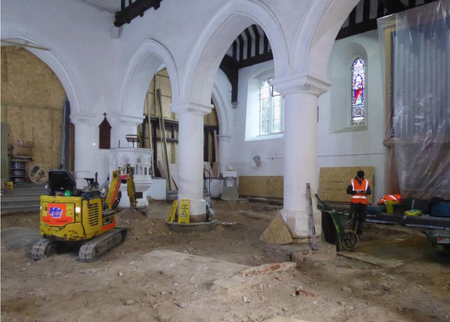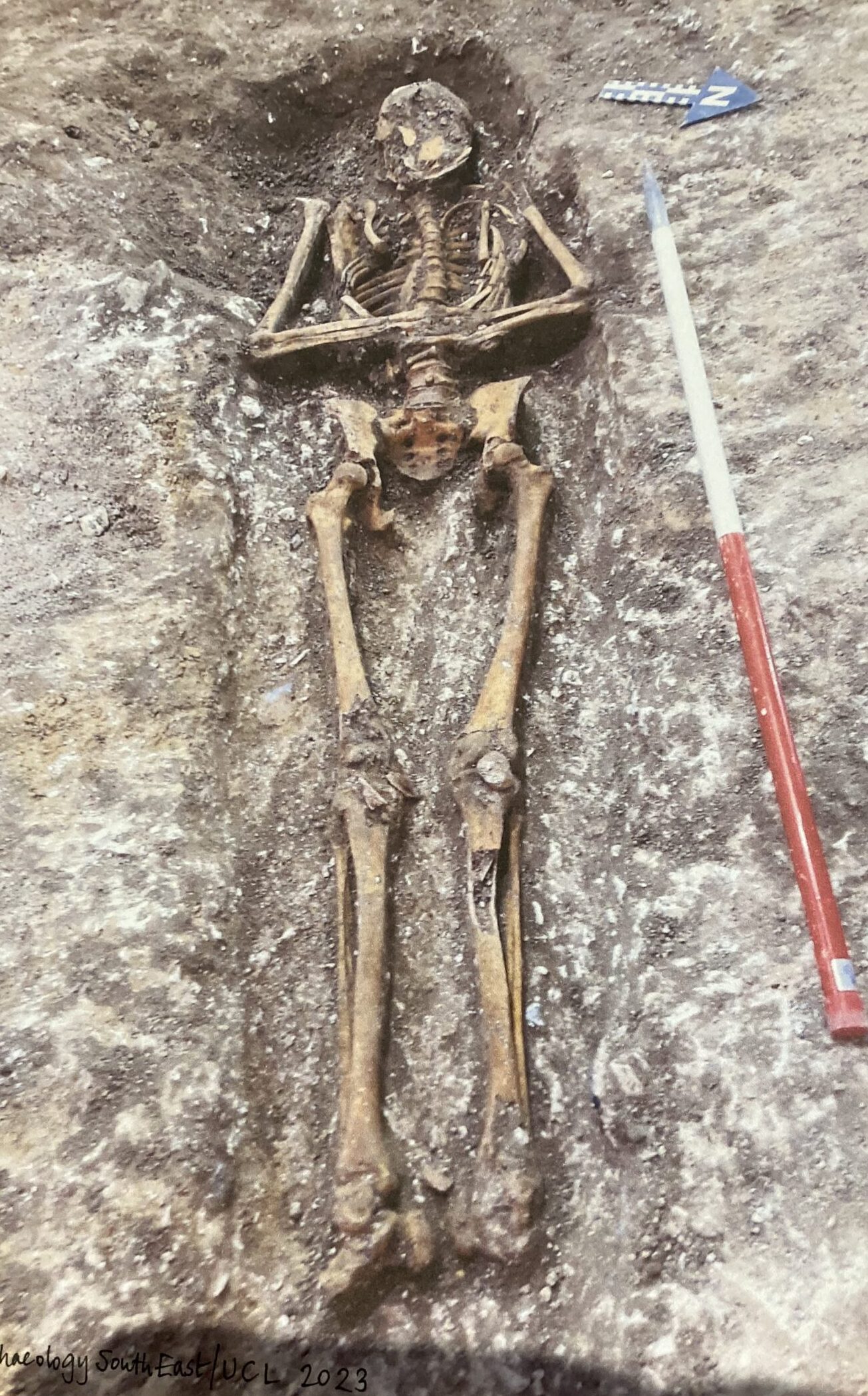 Abraham Lincoln
If given the truth, the people can be depended upon to meet any national crisis...
Abraham Lincoln
If given the truth, the people can be depended upon to meet any national crisis...
 Guildford news...
for Guildford people, brought to you by Guildford reporters - Guildford's own news service
Guildford news...
for Guildford people, brought to you by Guildford reporters - Guildford's own news service
11 Skeletons Found at Guildford’s Oldest Church
Published on: 21 Nov, 2023
Updated on: 23 Nov, 2023

St Mary’s with the excavation underway
By Mary Alexander
formerly of Guildford Museum
Eleven skeletons were discovered in the excavations at St. Mary’s Church in Quarry Street in 2019 and 2020, an audience of local history enthusiasts were told on Saturday (November 18).
The excavations were carried out by Archaeology South East, part of University College London, and headed by Chris Russel. They had been called in to examine the church floor prior to renovations at the church to improve access and install underfloor heating.

Some of the human remains found in the excavation at St Mary’s. Photo with kind permission of Archaeology South-East
The most interesting discovery was of eleven skeletons in the church and churchyard. Three of these were radiocarbon dated to the 11th and 12th centuries (radiocarbon can only give a span of dates, not a single one.)
This is exciting because some of them are probably late Anglo-Saxon (before 1066). Most of the skeletons inside the church were in the north aisle.
Three of them were complete and two had bones missing. This may be because of later burials, or because of later re-flooring work.
All but one of the bodies were positioned as usually found, on their backs with arms by the sides or crossed at the waist. But one body was unusual because the torso was on its side, while the legs were straight.
This body was of a mature adult, around 30 to 45 years, and about 5’ 3” to 5’ 4” tall but it was not clear whether it was a man or a woman. The remains dated from anywhere between 1035 and 1220 but are probably from the earlier part of this range.
The grave had been partly cut into for another burial, also a mature adult, probably a male of around 5’ 8” high. His bones had signs of a hard-working life with a lot of twisting, bending and lifting.

The skeleton truncated at the waist by post-burial construction. Photo with kind permission of Archaeology South-East
The third skeleton in this area had been cut through at the waist when the north transept was built. This was after the Norman Conquest of 1066, and before 1100 or a little later. The nave and south transept were built at the same time.
All three bodies may have been buried before this. The third skeleton was probably a rather short, mature woman between 4’ 9” and 5’ 1” high. It was dated from 1030 to 1220, and has to be in the early part of the range.
There was also one skeleton in the south aisle. It was a mature adult but height and sex could not be estimated. It was dated to 1050-1265, and again, perhaps earlier in the span.
The skeletons were not far below the surface, which seems odd. The excavator thought that when the nave was built the ground was levelled down, removing the upper levels of soil and probably many other skeletons.
We know from wills of around 1500 that several people were buried in the nave but they are no longer there. They may have been removed when the church was restored in 1863, or when a new floor was laid in 1967. Only those with sufficient wealth or status were normally buried within the church.
Five more skeletons were found when the foundations for the new porch were dug. They were definitely buried outside the church. These were later than the medieval period, and seem to have been buried when the churchyard was very full, as they were close together. All the bones which had to be removed have been re-buried in the churchyard.
Four brick burial vaults were uncovered in the nave but were not affected by the building work. By chance, I discovered that one was the family vault of Dr Thomas Remington who died in 1832. His wife died in 1805.
Responses to 11 Skeletons Found at Guildford’s Oldest Church
Leave a Comment Cancel reply
Please see our comments policy. All comments are moderated and may take time to appear. Full names, or at least initial and surname, must be given.Recent Articles
- Letter: If GBC Wishes To Be Nature-friendly, Stop Spraying Weedkiller
- Conservation Groups Say Government Policies Are a Threat To Wildlife
- Have You Seen Alexander?
- Millions of Taxpayer Money Recovered from Railway Fare Dodgers
- Notice: Have a Blooming Picnic – June 7
- Letter: This CIL Injustice Needs To Stop
- Another Surrey Council Is Fighting Off Bankruptcy
- Danish Brands Add Nordic Charm to Guildford’s High Street
- County Council’s Lead Member for Children’s Services Steps Down Following Criticism
- Letter: Come to Our Open Day this Saturday


Recent Comments
- John Lomas on Stoke Mill To Be a Pub If Plans Are Approved by Borough Council
- Rebecca Brion on Letter: Is This the Ugliest Building in Guildford?
- Brian Quinn on Letter: This CIL Injustice Needs To Stop
- Jacques Pillay on Remembering the Guildford Pub Bombings on the 50th Anniversary
- Nigel Keane on Letter: Is This the Ugliest Building in Guildford?
- Nigel Keane on Danish Brands Add Nordic Charm to Guildford’s High Street
Search in Site
Media Gallery
Dragon Interview: Local Artist Leaves Her Mark At One of England’s Most Historic Buildings
January 21, 2023 / No Comment / Read MoreDragon Interview: Lib Dem Planning Chair: ‘Current Policy Doesn’t Work for Local People’
January 19, 2023 / No Comment / Read MoreA3 Tunnel in Guildford ‘Necessary’ for New Homes, Says Guildford’s MP
January 10, 2023 / No Comment / Read More‘Madness’ for London Road Scheme to Go Ahead Against ‘Huge Opposition’, Says SCC Leader
January 6, 2023 / No Comment / Read MoreCouncillor’s Son Starts Campaign for More Consultation on North Street Plan
December 30, 2022 / No Comment / Read MoreCounty Council Climbs Down Over London Road Works – Further ‘Engagement’ Period Announced
December 14, 2022 / No Comment / Read MoreDragon Interview: GBC Reaction to the Government’s Expected Decision to Relax Housing Targets
December 7, 2022 / No Comment / Read MoreHow Can Our Town Centre Businesses Recover? Watch the Shop Front Debate
May 18, 2020 / No Comment / Read More












Laura Musgrave
November 21, 2023 at 7:28 pm
Thanks so much to Mary, the other speakers and the organisers for a very interesting and thought provoking talk.